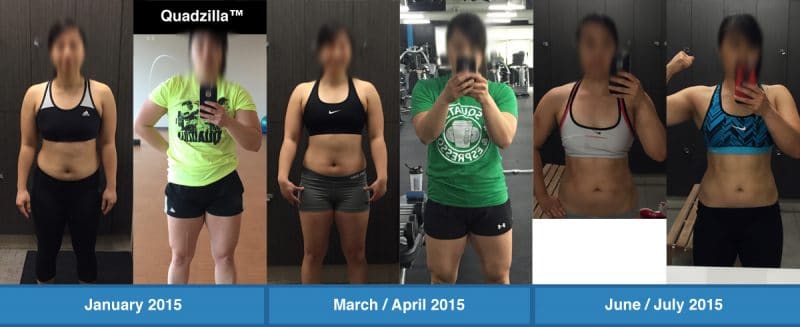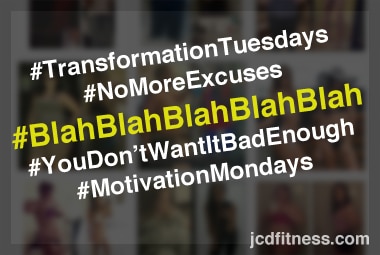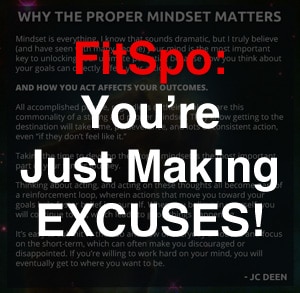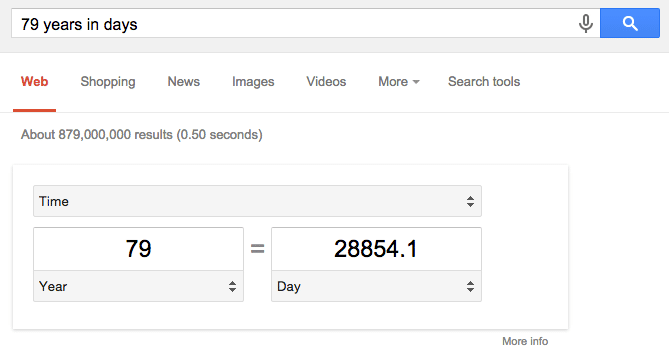

—
When you’re trying to get swole, jacked, lean, toned, diced, ripped…whatever the goal, everyone has one thing in common: EXPECTATIONS.
Body transformation is the number one goal that comes in on my coaching application form.
And it’s for good reason… everyone wants to lose fat, increase their muscle mass, and feel great doing it.
And with all of the before/after transformation photos you see, it’s incredibly difficult to manage your expectations, or even know what’s possible for you in a particular timeframe.
If you saw 10 Instagram posts of 12-week transformations where people continually lost a drastic amount of weight, you might begin to believe that was the norm, and that if you just put in the work for 12 weeks, you’d have a similar transformation.
So you saw 10 others lose 20 pounds in 12 weeks? Great, then it must mean you can do the exact same, right?
There are two possibilities here.
Either you can replicate their results or you can’t. So it’s a 50/50 toss-up.
But have you ever asked yourself this one question?
“Where are all the before/afters who tried the same routine and diet program and only lost 3 pounds?”
As you might imagine… those stories are not told. No one celebrates such ‘lack of progress’ because let’s face it. It’s just not sexy. Who wants to work their ass off to only lose 3 pounds in 3 months!?
NO ONE.
But the truth of the matter is no one can ever predict your outcomes.
Not I, nor the supplement pimp on Instagram promising you big bicep pumps.
Not even the most seasoned coach in the world… But why?
Because we’re all different, and we all come from varying places.
So even if you were to somehow discover the best training and nutrition plan in the world, your results will still vary when put up against someone else’s.
You might blow them out of the water with how much fat you lose and how much muscle you gain. You might get super strong while someone else of a similar starting point drastically loses strength or gets injured.
You might only lose fat, and not gain any muscle.
Someone else might gain muscle and get really fat.
What Body Transformation Expectations Are You Succumbing To?
The problem lies within the expectations you set for yourself when they’re based on outside sources.
Those sources are in the form of what’s projected onto you as being ‘normal’ or ‘typical.’ And when you’re flooded with a ton of before/after pics on Facebook and Instagram (which can create some harshly unrealistic expectations), it’s hard to consider any other reality.
And then when the going gets tough, it’s easy to give in and say “this isn’t working” or “I don’t have what it takes.”
After all, you’re a hard worker, and you deserve to make the most progress because you’re worth it.
And if you achieve anything less, you’ve probably just made excuses!

Does this sound familiar? If so, the italicized text above is me mocking the motivational garbage you see all over the internet. Don’t ever let anyone tell you you’re making excuses when you’re doing your very best.
Life can be hard, and it doesn’t always work out exactly how we want.
And that’s okay, but only under one condition: you don’t give up, and you don’t settle or lower your standards.
But here’s the rub: what you’re doing is better than what you were doing before, especially if you’ve been inconsistent with training and nutrition in the past.
So what if it takes you 30 weeks to achieve a drastic transformation?
Would it mean more to you if I told you that it’s very hard to maintain the results you get when they happen rather quickly?
12 weeks is not a lot of time when you consider the length of your life, and more importantly, the habits and processes you develop over a lifetime.
In the US, the average life expectancy is 79 years. That is 28,854 days according to the maths.

So what if you get super ripped by losing 20 pounds in 3 months? Does it matter when you’re left feeling hungry, deprived, and weak because you’ve been eating 1000 calories per day for 84 days straight?
Nah, because that pendulum is going to swing like a sledgehammer to the other side, and you just might undo that hard work, and what’s to come is never good for the mind or body.
I am all about process. And when it comes to working with individuals… I want the process of doing the work day in and day out to be cemented into your habits.
To get a better understanding of my view on Process-oriented goals versus Outcome-oriented goals, check out this video:
What 13 Pounds In 8 Months Looks Like
Today, I’m profiling a current client, Stephanie, who has absolutely rocked the process in changing her body, and managing expectations, but if you were to simply look at the numbers, you might not be impressed.
You might actually get discouraged if you’re conditioned to think that everyone can experience a drastic transformation in 12 weeks by following Just One Weird Trick.
Seriously… 13 pounds lost in 8 months is hardly one of those amazing stories. In fact, you might gloss over it if that was the headline, am I right?
So instead of looking at where you’re at and where you want to go with some harsh timeline in mind, what if you pushed those timeline expectations out of your reasoning?
What if I told you that the results would come but only if you kept putting in the work?
There was no grand timeline, just an expectation to make the day count, and to do your absolute best.
Would you feel better about the process?
Let’s have a look at Stephanie’s progress.
| Measurements | Starting Stats | Current stats | Difference |
|---|---|---|---|
| Body weight (pounds) | 158 | 145 | -13 |
| 2” above navel | 31 inches | 26 inches | -5 inches |
| At the navel | 34 inches | 29.5 inches | -4.5 inches |
| 2” below navel | 39.5 | 33.75 | -5.75 inches |
Here’s some background info on Stephanie:

Goal: Body Transformation (muscle gain, fat loss, more strength)
Occupation/lifestyle: Editor for Bodybuilding.com, Writer at Lifehacker, Creator of FitnGeeky.tv
Timeframe: 9 months (10/6/14 – 7/17/15)
Average training frequency: 4x per week
—
Stephanie got through three grueling programs with me – all of which included strength training, metabolic training (superset and tri-sets), and even some conditioning work.
We did zero traditional cardio, meaning we didn’t focus on long duration jogging, or biking, and focused mostly on nutrition and training.
The goal of the entire process over the last 8 months was getting a quality muscle contraction with each exercise and generating intensity with the loads lifted.
And of course, the emphasis was to get stronger over time, as known as progressive overload.
Our main aim was Fat Loss, with improvements in her ability to withstand the volume and conditioning over time.
I wanted to give you an insight into Stephanie’s view as well, so it wasn’t completely one-sided in how we approached all of this. My questions are in bold, and her replies below.
What got you interested in training and wanting to change your body?
Stephanie: For a long time, I’d always believed that with hard work and dedication, results would come. It sounds familiar because it’s a message I think that’s incessantly drilled into people’s heads in fitness, in business, and all other corners of life.
By my definition, I worked hard. I thought I was doing everything right: worked out in some capacity every day (e.g. 7+ mile trail runs, hours of Ultimate frisbee, 5+ miles road running, 25+ miles cycling, etc.) and tried to watch what I ate but never tracked.
I’d always taken pride in being fitter than most of my friends.
Then I started working at Bodybuilding.com, which flipped the idea of merely being fitter into being “stronger.” And to be stronger, I concluded, I needed to lift weights.
Through work [at Bodybuilding.com], I learned that weight training really can change the body in ways that I never could with the things I’d been doing.
It was around that time that I decided if what I’d always believed to be right never worked, then I needed to give this (weight training seriously and eating more) a shot.
JC note: Learn more about Stephanie. Or watch the video:
What type of training and diet were you following before we started?
Stephanie: It was all over the board – I never followed anything too formal.
Like most women, I’d emphasized the cardio and truly centered my entire fitness around “eat less, move more.”
In my mind, I had justified nearly all of my activities as a way to keep weight down and eat, although I found myself constantly mentally and emotionally conflicted because my body never changed.
I never did traditional cardio indoors, as that bored me to death, but I ended up doing things like cycling, Ultimate frisbee, rock climbing, distance running, snowboarding, swimming, anything—you name it, I probably tried it as some point (or at least intend to).
At some point, I dabbled a bit in weight training, taking interest in trying to deadlift double bodyweight, but still hadn’t followed a formal program and hurt myself.
We got through 3 different training programs together — what did you learn, and what was challenging about the training styles?
Stephanie: All of the programs that you gave me were often shorter than many programs I see around at work (which skews expectations of the kind of stuff that’s necessary to get results, but I’ll hit on that a bit in the question below).
At first, I’d questioned some of the movements; they seemed deceptively easy, but I quickly learned that I get out what I put in (short rest times, pushing myself regardless of how tough it is, learning to feel how intense high intensity is, etc.)
Perhaps it wasn’t until the 2nd training style with the body part isolation, bodybuilder-type style that I learned I needn’t lift heavy-ass weights all the time to feel like I’m making progress.
That shit burns.
There were definitely many times, especially on quad days and certain ab movements where I quite literally yelled “fuck you, JC” to the empty gym.
The interesting part here is that I stuck to the program basically for like 12-13 weeks at a time, almost never deviating or adding workouts unnecessarily.
I trusted JC and wanted to make sure I got the most out of his counsel (cuz not to blow smoke up JC’s ass but what’s the point of having a coach if I’m not going to listen?).
This kept me from program hopping, and really allowing my body to develop from consistent weekly training over those periods, which I think has shown in my muscle definition.
Here’s Stephanie pulling 275 pounds:
Did you ever get super frustrated/mad/sad about progress?
Stephanie: My texts to JC vacillate between happy, sad, neurotic, straight-up crazy, and silly constantly. It’s a damn emotional and mental trip.
I knew that getting results would take time, effort, and consistency, and so I put in the work day-to-day, week-to-week, month-to-month.
Initially, I’d been so adamant about sticking closely to the training program, the macros JC gave me, and the recovery protocol that I’d almost felt like a machine. Results were bound to happen, I thought.
But the scale and the measurements were so. goddamn. slow.
My timeframe would be irrelevant for anyone else’s, but I’d been working with JC for 8 months. In that time, I’d lost 13 pounds or so, 9 of which were lost in the last 3 months.
And so for 6 months, yes, I lost a mere 4 pounds, doing everything I thought was right. I freaked out plenty of times, and tempered these feelings with bouts of rationalization, like “Trust the process, it’s slow and steady.”
Mostly, it was to soothe the sting of such torturous progress for the amount of work, but also I came to the realization that: I’d finally “arrived” at a point where I couldn’t imagine waking up every day without a sense of purpose.
If I’d just quit, then I’d simply return to the alternate reality in which I’d pine for the very things I was already doing, if that makes sense. And so I opted to push through, because at that point, all the work was simply a process.
I will say that my work environment constantly screwed up my expectations and my tendency to compare my own progress to others. Obviously, everyone else was getting “somewhere” a lot faster than I was, but at the expense of what, I’m not sure.
It may be hypocritical of me to say, but as much as I wanted to do it sanely (training only an hour 4x a week and eating as much as I could get away with and make progress), my adherence to the plan had become a little insane.
It wasn’t until late May that I made a few tweaks (changed food tracking apps from MyFitnessPal to Cronometer, which made a MAJOR difference) and also started identifying hidden stressors that my body finally started to respond a bit more.
Oddly, I finally started shedding weight and fat more rapidly while I was still eating quite a bit and also tracking very loosely.
At the same time, I increased my daily activity in addition to my training, which initially I thought was completely unnecessary.
For a while, I’d tried to get away from my old trap of “eat less, move more” by stubbornly moving less, but that backfired since my progress was barely going anywhere.
Okay, there are a few things I want to point out in this timeframe of guiding Stephanie that she mentioned above.
Many times… you won’t see the progress in the mirror, even if you’ve made a ton of it. We see ourselves in the mirror daily, and the changes to our physique are happening very slowly. So we fail to see the small changes that add up to big changes.
Periodically, I’ll send people some starting images compared to their current ones. Here’s a screenshot of an iChat one day:

The Purpose Of The Process
In the above, she mentioned sticking the process. There’s a huge difference in doing something as a means to an end, and doing something because it’s a part of your being.
When you’re dieting hard for a show, or some event with a hard deadline, it’s easy to make a sacrifice and justify that as being a means to an end.
But with that comes some backlash. If you cut out things from your life that aren’t sustainable long term, you will eventually throw in the cards, and go back to the old behaviors.
For instance, let’s say you love carbs. And in order to get ready for your beach vacation, you drastically cut them to nothing. Sure, it will get you quick results, but you can’t do this forever for 2 reasons:
- It’s impractical to not eat carbs because most people eat carbs, and they’re tasty, and usually served with every meal, and they’re beneficial, and necessary for your body, your performance, and your brain.
- Your body will eventually fight back, and cause stress levels to peak, causing you more harm than good. Ever see the low carb person who looks gaunt, frail, and weak in the gym? Too long without glucose, and rarely anyone does too well.
The best thing Stephanie did this entire time was trusting the process that her hard work and attention to detail would pay off.
Months went by without much in mirror changes, measurements or scale wight. But the progress photos don’t lie. Here’s a snapshot of the timeline:

– larger version of the graphic –
Hidden Stressors Could Be Screwing Up Your Results
Stephanie is a true foodie. Just check her Instagram.
But one thing that really helped her let go of some unnecessary stress was to adopt a method of uniform eating that I practice, and encourage others to practice as well.
What this means is that you tend to eat similar foods on a daily basis to ensure the following:
- accurate tracking of macros
- frees up some mental space to think about other things, rather than trying to make every new recipe fit your macros
When you suddenly stop stressing over something like what you’re going to eat for breakfast tomorrow, and how that will affect lunch and dinner macros, you’ve suddenly freed up your mental bandwidth to worry about other things, or to not worry at all.
Another thing we worked on was cutting off work activity at a certain time period, and getting into a better bedtime ritual.
Stephanie works a lot, and always has projects going. In fact, she was the main editor for my women’s program HOT BOD.
So making sure to take that extra time for herself was huge in letting go of some unnecessary stress in her life.
Why Tracking Matters In Helping Make The Proper Adjustments Over Time
Steph mentioned dropping MyFitnessPal for Cronometer as her primary macro tracking tool. And within a few weeks, she noticed just how varied some of her meals and macros were based on inconsistent reporting from the MFP app when compared to Cronometer.
This can make a huge impact over time when you consider that overeating by 300-500 calories per day could severely impact your progress.
I should note this is not the first time I’ve seen this happen, and I most always recommend my people use Cronometer over any other macro tracker.
She was also great at tracking her training and making sure to let me know how it was going so we could make the proper adjustments over time because it’s rarely a perfect world where someone can magically go through a program over 12 weeks without needing to tinker and make some changes.
Want To Work Toward Similar Results?
Fill out the coaching application — it’s completely free. Then let’s have a chat about your goals, and what you’d like to accomplish in the next 6 months.
